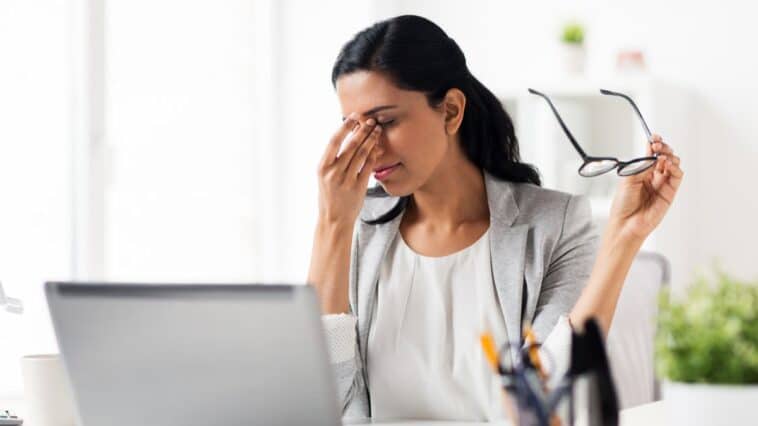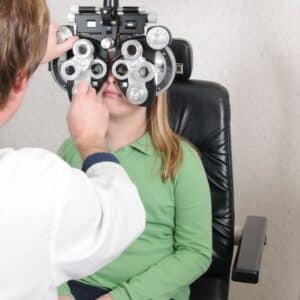What are Stressed Eyes?
Stressed eyes are a condition where the eyes experience discomfort or strain due to prolonged and excessive use, often caused by activities such as reading, staring at a computer screen, driving, or exposure to bright lights.
Stress on the eyes is a common issue, especially for those who spend extended periods staring at the computer or mobile screens. However, there are steps you can take to alleviate the strain. Simple eye care practices can help prevent or reduce symptoms of eye strain.
How Stress Can Affect Your Vision
Stress can have a significant impact on your vision. When you experience stress, your body responds with a fight-or-flight response, triggering the release of hormones such as cortisol and adrenaline. This response can cause your pupils to dilate, your heart rate to increase, and your blood vessels to constrict, leading to changes in your vision.
One of the most common ways stress affects vision is by causing eye strain or eye fatigue, which can result in blurred vision, dry eyes, and headaches. Prolonged periods of stress can also contribute to developing conditions such as myopia (nearsightedness) and exacerbate existing vision problems such as astigmatism.
Stress can also increase your risk of developing certain eye diseases, such as glaucoma, cataracts, and age-related macular degeneration (AMD). Studies have shown that stress can affect the fluid pressure inside your eyes, potentially leading to damage to the optic nerve and vision loss.
In addition to these physical effects, stress can also impact your mental health, affecting your vision. Chronic stress can lead to depression and anxiety, which can cause changes in your visual perception and color vision.
It’s essential to manage stress and take steps to protect your vision. If you’re experiencing prolonged or severe eye strain or other vision problems, it’s best to see an eye specialist to rule out any underlying conditions and discuss appropriate treatment options.
Causes of Stressed Eyes
Stressed eyes can be caused by a variety of factors, including:
- Digital Eye Strain: Spending too much time staring at digital screens like computers, smartphones, and tablets can lead to digital eye strain, causing symptoms like dry eyes, headaches, and blurred vision.
- Poor Lighting Conditions: Poor lighting, whether it’s too bright or too dim, can put a strain on your eyes.
- Lack of Sleep: Lack of sleep can cause eye fatigue, dryness, and irritation.
- Allergies: Allergies can cause itchy, red, and watery eyes, making them feel stressed and uncomfortable.
- Eye Infections: Eye infections like conjunctivitis or pink eye can cause redness, swelling, and itchiness in the eyes, leading to stress and discomfort.
- Contact Lenses: Wearing contact lenses for extended periods can lead to dryness and irritation, causing eye stress.
- Environmental Factors: Polluted air, dusty environments, and extreme weather conditions like wind, sun, or cold can stress your eyes.
- Medical Conditions: Certain conditions like glaucoma, diabetes, and thyroid problems can cause eye stress.
- Emotional Stress: Stressful situations can cause tension in the body, including the eyes, leading to discomfort and fatigue.
It’s essential to identify the cause of your stressed eyes and address them to prevent further damage to your eyesight.
Symptoms of Stressed Eyes
Stressed eyes can manifest in a variety of symptoms. Some of the most common symptoms include:
- Eye strain is a feeling of discomfort or tiredness in the eyes after prolonged use, such as staring at a computer screen or reading.
- Dry eyes: Dry eyes can be a result of inadequate tear production or rapid evaporation of tears, leading to discomfort, burning, and irritation in the eyes.
- Watery eyes: This can occur when the eyes try to compensate for dryness by producing excessive tears.
- Blurred vision: Stress can cause the pupils to dilate, leading to blurry vision.
- Eye twitching: This is a repetitive, involuntary spasm of the eyelid, often caused by stress.
- Sensitivity to light: Stress can make the eyes more sensitive to light, causing discomfort and pain.
- Headaches: Stress can cause tension headaches, leading to eye strain and discomfort.
- Eye fatigue is a feeling of exhaustion in the eyes that can occur after prolonged use.
- Difficulty focusing: Stress can make it difficult to focus on tasks, especially those that require visual attention.
- Eye floaters: These are specks or spots that appear in the field of vision and can be caused by stress-related changes to the vitreous humor.
Other factors can also cause these symptoms, so it is best to consult an ophthalmologist to determine the underlying cause.
Treatment for Stressed Eyes
How do you fix stressed eyes? Treatment for stressed eyes can vary depending on the underlying cause and severity of the symptoms. However, some general steps can help alleviate eye strain and reduce stress on the eyes:
- Rest your eyes: If you spend a lot of time looking at a computer screen, take frequent breaks to rest your eyes. Follow the 20-20-20 rule: every 20 minutes, take a break and look at something 20 feet away for 20 seconds.
- Adjust your screen: it’s essential to adjust your screen correctly to reduce eye strain while using your computer; position your screen so that your eyes are level with the top of the screen. Additionally, adjust the brightness and contrast settings to a comfortable level. This will help prevent eye fatigue and discomfort.
- Blink frequently: it’s crucial to blink frequently when staring at a screen for extended periods to prevent dryness and irritation; by consciously trying to blink more often, you can keep your eyes lubricated and comfortable.
- Use artificial tears: Over-the-counter eye drops can help relieve dryness and irritation. Look for “artificial tears” or “lubricant eye drops.”
- Improve lighting: Ensure your work environment is well-lit, and your computer screen has no glare or reflections. Avoid working in dimly lit rooms or areas with high-contrast lighting.
- Take breaks: It is essential to take regular breaks from work and give your eyes a rest. Get up, move around, do some stretches, or walk.
- Consider glasses: If you spend much time looking at a computer screen, you may benefit from glasses designed for computer use. These glasses can reduce eye strain and improve clarity.
- Manage stress: Reducing stress levels through relaxation techniques, exercise, and other stress-management techniques can also help reduce eye strain and promote eye health.
If your symptoms persist or worsen, seeing an eye doctor for a comprehensive eye exam is essential. They can evaluate your vision, assess underlying conditions, and recommend appropriate treatment options.
Prevention Tips to Avoid Stressed Eyes
Preventing stressed eyes is essential for maintaining good eye health and avoiding discomfort. Here are some tips to help you avoid future stressed eyes:
- Maintain proper distance and posture: Sit at an appropriate distance from your computer screen and adjust the height of your chair and computer screen to ensure your eyes are level with the top. Maintain good posture to reduce neck and shoulder strain.
- Use anti-glare screen filters: Anti-glare screen filters can reduce the amount of glare from your computer screen, making it easier to view.
- Limit screen time: Try to limit your screen time outside of work and engage in other activities that don’t involve screens, such as reading a book or going for a walk.
- Stay hydrated: It’s vital for overall health, but did you know drinking enough water can also benefit your eyes? Keeping your eyes hydrated can help reduce dryness and irritation, so drink plenty of water throughout the day.
- Exercise your eyes: Practice eye exercises such as blinking, focusing on distant objects, and moving your eyes from side to side. This can help reduce eye strain and fatigue.
- Maintain a healthy lifestyle: it’s crucial to prioritize your eye health; this means eating a balanced and nutritious diet, staying hydrated throughout the day, and getting enough restful sleep each night. Additionally, regular exercise can help improve blood flow and circulation, positively impacting your eyes.
- Get regular eye exams: Regular eye exams can detect changes in your vision and help identify and treat potential eye problems before they become more serious.
By following these prevention tips, you can help reduce the risk of eye strain and maintain good eye health. If you experience any eye strain symptoms, talk to your eye doctor for advice on treatment and prevention.
When to See an Eye Doctor for Stressed Eyes
If you are experiencing eye strain symptoms impacting your daily activities or causing discomfort, it may be time to see an eye doctor. It is essential to schedule an appointment with your eye doctor if:
- Symptoms persist: If you have been experiencing symptoms of eye strain for a prolonged time, such as several days or weeks, and they do not seem to be improving, it is essential to see your eye doctor.
- Severe symptoms: If your symptoms are severe and causing significant discomfort, such as severe eye pain, double vision, or difficulty seeing, it is crucial to seek immediate medical attention.
- Difficulty performing tasks: If your symptoms are interfering with your ability to perform daily tasks such as reading, driving, or working on the computer, it may be time to see an eye doctor.
- Vision changes: If you are experiencing changes in your vision, such as blurriness or difficulty focusing, it is essential to schedule an appointment with your eye doctor to rule out any underlying eye conditions.
It is always better to be safe than sorry when it comes to your eye health, so if you are experiencing any concerning symptoms, don’t hesitate to make an appointment with your eye doctor.






